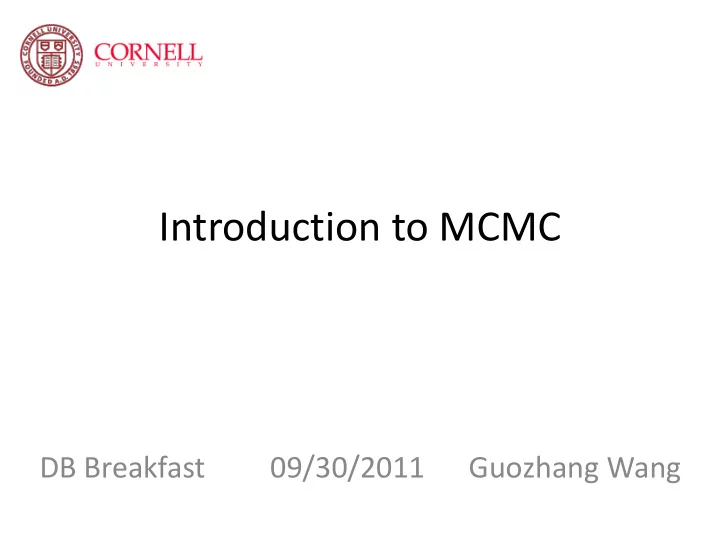

Introduction to MCMC DB Breakfast 09/30/2011 Guozhang Wang
Motivation: Statistical Inference • Joint Distribution Sleeps Well Playground Pleasant dinner • Posterior Estimation Sunny Bike Ride Productive day Graphical Models
Motivation: Statistical Physics • Energy Model • Thermal Eqm. Estimation Ising Model
Problem I: Integral Computation Posterior Estimation: Thermal Eqm. Estimation:
Problem I Rewrite: Sampling • Generate samples {x (r) } R from the probability distribution p(x). • If we can solve this problem, we can solve the R integral computation by: ( r ) ( r ) f ( x ) p ( x ) i • We will show later this estimator is unbiased with very nice variance bound
Deterministic Methods • Numerical Integration – Choose fixed points in the distribution – Use their probability values • Unbiased, but the variance is exponential to dimension
Random Methods: Monte Carlo • Generate samples i.i.d • Compute samples’ probability • Approximate integral by samples integration
Merits of Monte Carlo • Law of Large Numbers – Function f(x) over random variable x – I.i.d random samples drawn from p(x) 1 n as n f ( X ) f ( x ) p ( x ) dx i i 1 n • Central Limit Theorem – I.i.d samples with expectation μ and variance σ 2 Sample distribution normal( μ , σ 2 /n ) Variance Not Depend on Dimension!
Simple Sampling • Complex distributions – Known CDF: inversion methods – Simpler q(x) : Rejection sampling – Can compute density: importance sampling
Come Back to Statistical Inference • Forward Sampling – Repeated sample x F (i) , x R (i) , (i) based on prior and x E conditionals – Discard x (i) when x E (i) is not observed x E – When N samples retained, estimate p(x F |x E ) as Problem: low acceptance rate
Problem II: Curse of Dimensionality • The “prob. dense area” shrinks as dimension d arises • Harder to sample in this area to get enough information of the distribution • Acceptance rate decreases exponentially with d
Solution: Sampling with Guide • Avoid random-walk, but sample variables conditional on previous samples • Note: violate the i.i.d condition of LLN and CLT
Markov Chain • Memoryless Random Process – Transition probability A: p(x t+1 ) = A*p(x t ) • Non-independent Samples, thus no guarantee of convergence
Mission Impossible? How can we set the transition probabilities such that the 1) there is a equilibrium, and 2) equilibrium distribution is the target distribution, without knowing what the target is?
Markov Chain Properties • A Markov chain is called: – S tationary , if there exists P such that P = A*P; note that multiple stationary distribution can exist. – Aperiodic , if there is no cycles with transition probability 1. – Irreducible , if has positive probability of reaching any state from any other – Non-transient , if it can always return to a state after visiting it – Reversible w.r.t P , if P(x=i) A[ij] = P(x=j) A[ji]
Convergence of Markov Chain • If the chain is Reversible w.r.t. P, then P is its stationary distribution. • And, if the chain is Aperiodic and Irreducible, it have a single stationary distribution, which it will converge to “almost surely”. • And, if the chain is Non-transient , it will always converge to its stationary distribution from any starting states. Goal: Design alg. to satisfy all these properties.
Metropolis-Hastings
MCDB: A Monte Carlo Approach to Managing Uncertain Data • Used for probabilistic Data management, where uncertainty can be expressed via distribution function. CREATE TABLE SBP DATA(PID, GENDER, SBP) AS FOR EACH p in PATIENTS WITH SBP AS Normal ( (SELECT s.MEAN, s.STD FROM SPB PARAM s)) SELECT p.PID, p.GENDER, b.VALUE FROM SBP b
MCDB: A Monte Carlo Approach to Managing Uncertain Data • Query processing – Sample instances from the distribution function – Execute the query on each sampled DB instance, thereby approximate the query-result distribution – Use Monte Carlo properties to compute mean, variance, quantiles, etc. – Some optimization Tricks • Tuple bundles • Split and merge
MCDB: A Monte Carlo Approach to Managing Uncertain Data • Limits – Risk analysis concerns with quintiles mostly – Requires lots of samples to bound error – Actually is the curse of dimensionality • MCDB-R: Risk Analysis in the Database – Monte Carlo + Markov Chain (MCMC) – Use Gibbs sampling
Thanks!
Recommend
More recommend